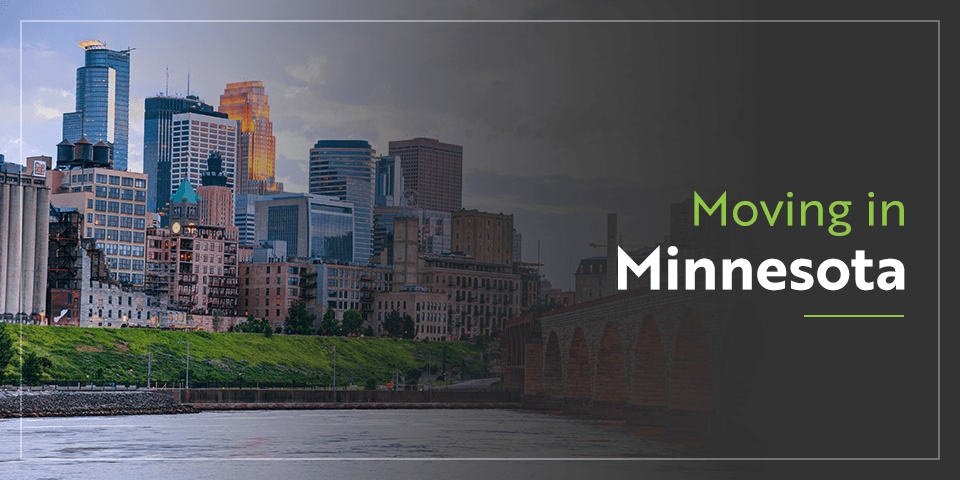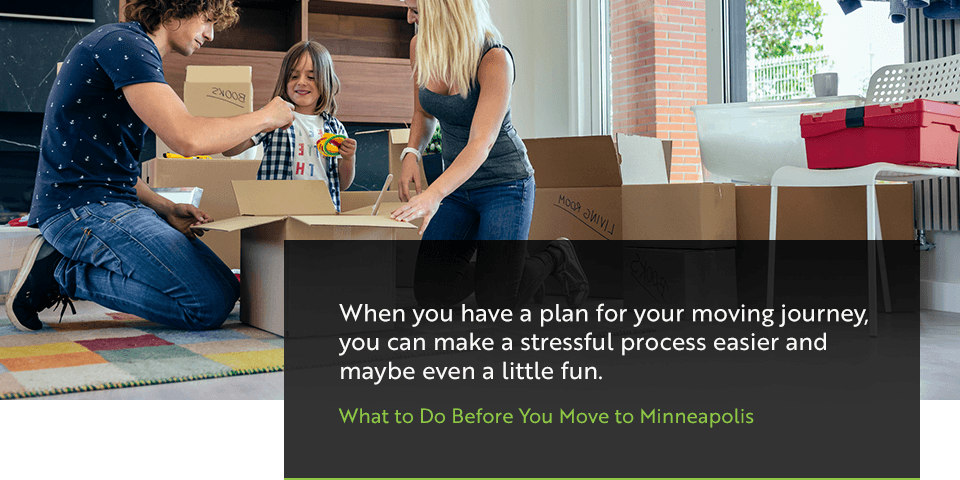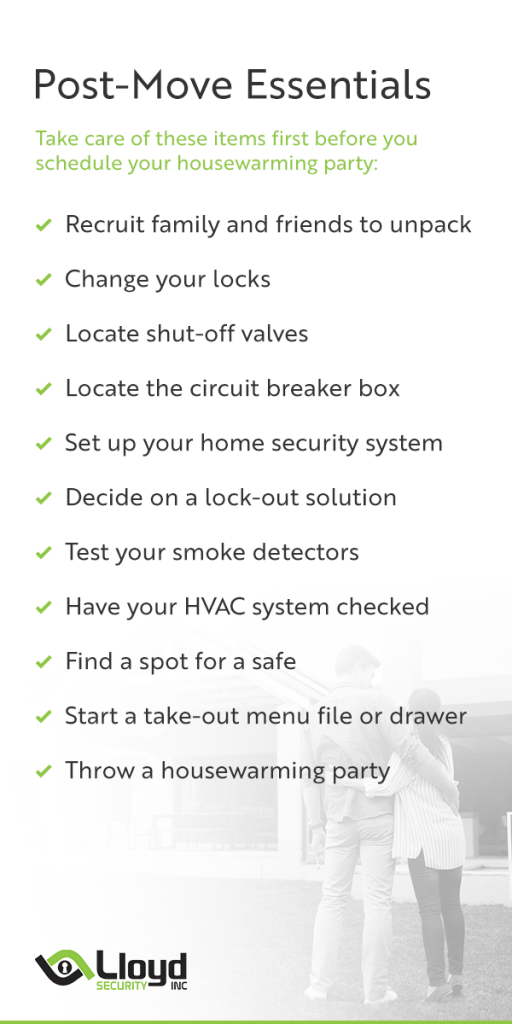
JUMP TO: What to Do Before You Move to Minneapolis | Post-Move Essentials
Are you getting ready to move to Minneapolis? If so, you might be wondering how to make your move here as seamless as possible. One of the first things you can do is to make a plan. This will help ease your mind during the process and make everything proceed as smoothly as possible. Take a look at these steps for moving to the Gopher State to help get you started and to make yourself feel right at home.
What to Do Before You Move to Minneapolis

When you have a plan for your moving journey, you can make a stressful process easier and maybe even a little fun. Take a look at the following tips before you load up the moving truck:
- Transfer utilities: Before you can settle into your new home, you need to set up water, gas and electricity. If you aren’t sure which companies to contact, you can ask the previous owner which ones they used for these services. Once you have what you need, give the utility companies your move-in date as soon as possible to prevent a lapse in service. Also, be sure to mark your calendar to pay any outstanding bills before you move.
- Set up your home security system: Moving into your home is the ideal time to start setting up your home security system. You can know who is coming into your home at all times with a home alarm system, and you might even get a discount from your insurance company. A video surveillance system gives you a second pair of eyes to watch over your home.While you’re away from the house, you can watch 20-second video clips of the outside and inside your home. You can connect your alarm systems and video surveillance systems to an app on your phone or tablet. The Alarm.com app provides you with access to your security system at the touch of your screen.
- Connect TV and internet: Check with your current cable and internet company to see if they provide services in the Twin Cities. Let them know your move-in date as soon as possible so that you can have a seamless transition from one home to the next. Cancel the current cable and internet services you have in your existing home before connecting the internet and TV in your new home.
- Update your address: Create a list of people and companies that have your address and send them your new address. You should also update your car registration and driver’s license. Additionally, you can set up a mail forwarding system at the post office. This system sends all mail to your new address after your move-in date.
- Gather vital documents: In the shuffle of moving, it’s easy to lose important documents. When you move, make sure you have a box or folder saved for all the documents you’ll need, and keep it handy so you can find it easily. Have a list of account numbers and contact information for any bank or other accounts as well as copies of medical and school records.
- Take photos of valuable items: Create an inventory of your valuables and take pictures of each of them. These items may include your TV or a family heirloom you’ve had in your family for generations. If you take pictures, you have evidence of their original condition. This makes it easier to get reimbursed for them or have them replaced if your professional movers break or damage them.
- Research local businesses: If you’re moving to a new town, you may need to find a new doctor or dentist. You probably will also need a new place to go for groceries and other necessities. Research businesses that will help you transition into your new location. Having this contact info on hand can help you enjoy your new home.
- Take off from work if possible: Taking a little time off of work during the moving process can make it a little less stressful. If you are going to be taking time off, though, be sure to let your employer know at least a couple of weeks in advance. If you’re going to be starting a new job when you move, make your start date at least a couple of days after you arrive. That way, you have enough time to get the essentials unpacked and ensure your utilities are set up.
- Schedule a cleaning: Before you move all your boxes and furniture into your new home, you might want to deep clean the house. To make things easier on yourself, schedule a cleaning service to do it.
- Schedule home improvements: New residents of homes often feel overwhelmed by all the work they have to do in the house. Take care of any home repairs you can before you move in so that they don’t interrupt your lifestyle. If you need help, don’t hesitate to get in touch with local professionals.
- Prepare to pack: Packing is the perfect opportunity for you to sort through your items and figure out what you need and what you don’t. As you start packing, make three piles — keep, donate and trash. Once you’ve decided what you’re going to bring with you, be sure to label your boxes based on their designated room. You can also assign a color to each room in the house and stick a colored label on each container. This labeling system expedites the moving process and organizes your valuables as you stack them in the moving truck. If you need boxes, you can save money by collecting boxes from local businesses. You could also use laundry hampers and suitcases instead of buying boxes as well.
Post-Move Essentials

Now that you’ve moved into your house, you can almost start celebrating. Take care of these items first before you schedule your housewarming party:
- Recruit family and friends to unpack: Invite as many friends or family members as you can to help you sort through your boxes. The process will go a lot smoother with more people helping you. You can treat them to a nice lunch or some drinks to repay them for their services. Make sure you have an unpacking plan before your friends arrive, so they know what you’d like them to do.
- Change your locks: If you’re moving into an existing home, install new door locks in case someone you don’t know — for example, a friend or family member of the previous owner — has a key to the house. You can either hire a locksmith or install the locks by yourself. For even more peace of mind, you can install a remote access control system right from your phone.
- Locate shut-off valves: You have to turn off the water if you have a leak in the house or you need a repair, so you need to know where the shut-off valves are. Check both the inside and outside of your home to find them now — so you don’t have to go searching for them later.
- Locate the circuit breaker box: The circuit breaker box controls all the electrical parts of the home. In case you blow a fuse or there’s a power outage, you will want to know where your circuit breaker box is. You can usually find it in the basement, the garage, a closet or a hallway. While you’re setting up your electrical system, you can also make your home a smart home. You can save money on your energy usage by monitoring your home’s activity from your phone.
- Decide on a lock-out solution: Make a plan for if you get locked out of your new house in the future. You could have a key under the doormat or install a garage code, for instance. You could also ask a neighbor to hold onto a spare key. Another option is to set up a remote access control system. Then you can use your smartphone to unlock the door if you lost your key.
- Test your smoke detectors: Your house should have more than one smoke detector to alert you in case of a fire. When you first move into your home, test the smoke detectors to make sure they all work. For further protection against smoke and fire, you can also invest in a home fire alarm.
- Have your HVAC system checked: Your HVAC system is what provides a comfortable temperature for your new living space. You should have someone check your HVAC system within the first few weeks of moving into your house so that you know it’s safe to use. HVAC repair costs can be expensive, and you want your system to be working correctly. You can also set up a residential energy management system. You can control your thermostat from anywhere with a wireless connection, which can potentially help you save money on your energy bills.
- Find a spot for a safe: You will probably want to have a safe for your important documents and other valuables. Familiar places to hide a safe include in a closet, in the basement or in the attic. However, there also may be somewhere different in your new home that is ideal for keeping your safe.
- Start a take-out menu file or drawer: With all these new local restaurants around you, you’re going to want to have a few menus on hand. While you are moving and your kitchen utensils are in boxes, you might wish to order take-out for a few weeks. Use your free time to decorate and unpack instead of thinking about what to make for dinner. When you find a restaurant you like, save the menu and put it in a drawer or a file to access later.
- Throw a housewarming party: Celebrate all the hard work you’ve put into your house with your friends and family. Setting a date for the housewarming party gives you an unpacking deadline. Just remember that when you have a housewarming party, the house doesn’t have to be perfect. Instead of worrying about the small fixes you still need to do, make time to enjoy your living space. If you have a chance to meet the neighbors, make sure you invite them as well.
Now That You’re Settled in, Enjoy Your New Home
After the housewarming party, you can explore all that Minnesota has to offer. You can enjoy the beautiful outdoors and the exciting sporting events in Minneapolis. Here are some of our favorite places to visit:
- Sports events: You can watch a live game of any sport in the Gopher State. The University of Minnesota is home to the Gophers. Whether you like watching a football game or a cross country tournament, you can enjoy a game at our local college. You could also watch a game from one of our professional teams, such as the Minnesota Vikings, the Minnesota Twins and the Minnesota Timberwolves.
- State parks: Minneapolis is home to some of the most beautiful state parks in the Midwest. You can go ice fishing in the winter and walk along nature trails at Fort Snelling Start Park in St. Paul. You could also have a picnic or play volleyball at Minnehaha Regional Park, and go for a bike ride at Mississippi Gorge Regional Park.
- Art galleries and museums: Be sure to visit the various art galleries we have in Minneapolis. If you are an art aficionado, you won’t want to miss the Minneapolis Institute of Art. It has exciting exhibits and events all week long. The Museum of Russian Art also boasts exclusive art from Russia in St. Paul.
- Museums: The Mill City Museum displays the history of flour milling in Minneapolis. Throughout the year, the museum offers special themed exhibits. You can take a tour of the oldest part of the city as you hear the stories of milling in Minneapolis. When the weather is pleasant, the Mill City Museum is also home to a farmers market and summer concerts.
- Theatre: The Minneapolis theatre district boasts an influx of rich culture over the years. Laugh or cry at your favorite live performance in one of the many theatres the Twin Cities have to offer. You could also go to a dinner theatre to grab a meal with your entertainment in downtown Minneapolis.
- Shopping: The Mall of America is the largest shopping center in the country. There are hundreds of stores in this building. Plan to spend at least one whole day here to check it out.
- Minnesota State Capitol: The Capitol building is right here in St. Paul. You can take a guided tour of this landmark to see the legislative chambers. You could also take part in special events throughout the year.
- Minnesota Zoo: A few miles outside of Minneapolis, the Minnesota Zoo zoo is home to a variety of animals from all over the world. They are open every day of the year. The zoo also offers special events to make your experience even better.
Let Lloyd Security Make You Feel Safe in Your New Home in the Twin Cities
Our goal at Lloyd Security is to welcome you to Minnesota. If you’re looking to have your security needs evaluated, we can help. We also offer installation and monitoring of your systems and home automation, such as smart thermostats, locks, lighting and more. Simply contact us online to discuss your needs. You can also call us at 612-874-9295.

